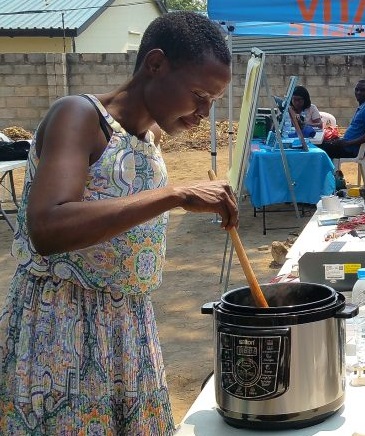- Date
- 30th September 2019
- Categories
David Ockwell, Professor of Geography, University of Sussex
MECS aims to transform access to modern energy cooking services within the next 5 years. The programme has a consortium of universities working on multiple aspects of the innovation process that is required to support such a transformation. It also has a wider network of delivery partners tasked with using this research to inform their actions in catalysing the afore mentioned transformations.

But it is vital to remember that what MECS’ vision entails is widespread changes in millions of people’s cooking practices and the technologies they use to support these practices. It is also vital to remember that MECS’ vision entails deliberately intervening to support such transformative change (as opposed to such a change happening without policy support).
One example of a deliberate intervention that transformed access to a new, clean technology was the IFC-funded Lighting Africa’s work in Kenya. This catalysed a transformation in the market for solar lanterns from 29,000 in 2009 to around 15 million today.
In our recent peer reviewed working paper (summarised in an accompanying MECS policy brief) we analyse the approach that Lighting Africa took and how MECS is learning from this. We show how Lighting Africa’s systemic interventions in Kenya are an excellent example of intervening based on a 5 dimensional understanding of how transformative innovation and technological change occurs. This is in sharp contrast to traditional 2 dimensional approaches, which have largely failed to deliver against the needs of poorer countries or poor and marginalised women and men therein.
2 dimensional understandings of innovation and technological change focus only on finance and technology hardware. A classic example of this is the clean development mechanism (CDM). Despite being a supposedly neutral market mechanism, around 60% of cumulative investment went to China, 15% to India and 12% to Latin America. Africa as a whole, including the relatively richer countries of Northern and South Africa, accrued less than 3%. And per tonne of carbon emitted annually, Africa’s share of CDM investment was less than half of any of these other countries’ and regions’ shares. Hardly a transformative result that meets the needs of poorer countries.
Decades of research have shown exactly why 2 dimensional, hardware & finance focussed interventions fail. It is because they ignore 3 other dimensions that are critical to transformative changes in social and technological practices. These are dimensions are:
- The social dimension. This demands we try to understand the lived realities of poor women and men and their specific, self-defined technological needs. Only if new technologies can fit with these existing perceived needs, or stretch people’s existing practices to accommodate new technologies, will any kind of widespread, sustained change in the adoption of new technologies occur.
- The political/political economy dimension. Even at the level of charcoal or woodfuel vending, political economies exist. Different people stand to lose or gain from a shift to modern energy cooking services. At a national level modern energy cooking confronts head on political economies around electricity production and distribution and political economies around oil. Existing narratives around what constitutes clean cooking technologies and how we should intervene to support clean cooking are also tied into a raft of probably difficult to identify political economies among different international organisations and national governments. Even a simple small scale hydropower plant at a village level has been demonstrated to be fundamentally entwined in politics, from the village level upwards, with often uneven, gendered benefits and dis-benefits. Trying to achieve transformations in clean technology adoption is doomed to failure if this political dimension of technology change is ignored.
- The innovation systems dimension. Transformative change also involves the crucial task of creating and strengthening linkages between, and capabilities of, key actors within a country’s innovation system (e.g. key private, public and civil society actors associated with different aspects of clean cooking technologies, from development, to distribution to financing, and so on). Collectively these are known as “innovation systems” and have successfully been used to explain economic growth and technological advancement that traditional economic theory was unable to explain (e.g. an innovation systems perspective has explained the growth of OECD economies, the Korean steel industry and the success of the off grid solar PV sector in Kenya).
Critically, innovation systems can be weak or non-existent in low-income countries. Upfront public sector support must therefore be provided to create the bedrock of an innovation system upon which private sector actors can later enter and grow the market for new technologies. It was exactly such public sector investment that underpinned the success stories mentioned above, and this will be required again to transform access to modern energy services.
We should end by emphasising that we are not for a moment suggesting that finance and technology hardware are not critical dimensions of transformative changes in the uptake of clean technologies. They are and will always be. But it is only when these other three dimensions (social, political and innovation systems) are addressed that deliberate interventions like MECS are ever likely to be successful in catalysing transformations.
Importantly, it is also critical that financial and technology hardware innovations are led by an understanding of, and continued interaction with, the social dimension. Without grounding innovation in the context of the lived realities of poor women and men, and the specific contexts and needs of low-income countries, transformations are highly unlikely to be catalysed. This was a key element in Lighting Africa’s success.
Have a read of our working paper to see how Lighting Africa successfully achieved a 5 dimensional intervention with transformative results, and how MECS is responding to this.